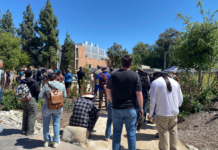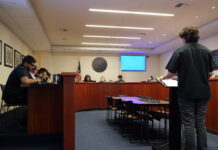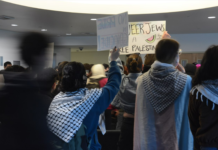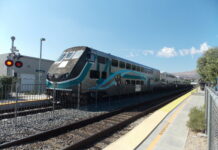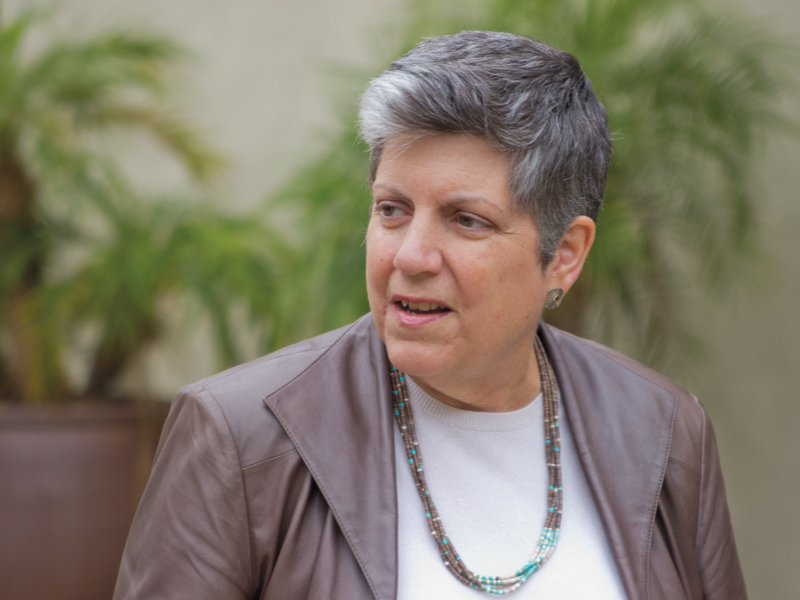
UC President Janet Napolitano is blazing a trail for several initiatives, which includes, but is not limited to: reducing the UC Office of the President’s (UCOP) budget by 6.5 percent, finalizing contract agreements with UC labor unions and reaching a carbon neutral standard by 2025. The president’s announcement occurred during the UC Board of Regents meeting at the UC San Francisco (UCSF) Mission Bay from Jan. 22-23.
The meeting revolved around the 2014-15 proposed state budget, which allocates a 5 percent increase — about $142 million — to the UC budget, falling $120.9 million short of what the regents requested in Nov. 2013. Napolitano planned to enact a freeze on systemwide tuition, which is needed to obtain the state’s $142 million allocation, but board members argue that proposed state funding levels will not be enough to support unfunded pension liabilities and increasing UC student enrollment in the future.
The two-day discussion also included a rare meeting between three leaders of the state’s public higher education systems: former UC Riverside Chancellor and current California State University (CSU) Chancellor Timothy White, UC President Napolitano and California Community College (CCC) Chancellor Brice Harris discussed revamping the 1960 California Master Plan for Higher Education — a blueprint for making public higher education more affordable and accessible to students in California.
UC president lays groundwork for further initiatives
Napolitano plans to pursue a budget over the next two years that will determine the “appropriate size, shape, and roles of the Office of the President,” while gathering input from the 10 UCs.
With the intent of “leading by example,” Napolitano has pledged to curb administrative expenditures by reducing travel expenses by 10 percent and capping overall staff at UCOP.
“Any replacement positions will be subject to prior approval by me or my designees, and departments will be required to develop staffing plans that address future needs and attrition,” reported Napolitano.
She will also provide support for undocumented students through her one-time allocation of $5 million for each UC campus. The funds will provide in-house staff training at student resource centers, create undocumented student advisory-group meetings, and offer additional financial support, such as UC student loans and work-study positions.
The UC president is also supporting postdoctoral and graduate students through her previous allocation of $10 million. Part of the fund will go to the President’s Postdoctoral Fellowship Program (PPFP) — a program that provides financial support for STEM scholars who are interested in becoming UC faculty members. The funding will also offer diversity fellowships to graduates who faced difficult conditions or situations that disadvantaged them academically and to undergraduates from Historically Black Colleges and Universities (HBCU) who are admitted to UC doctoral programs.
“Currently, only about 3 percent of Ph.D. students are African American, 1 percent are American Indians and 8 percent are Chicano/Latino, all less than the representation of these groups in California and the nation,” revealed the UCOP research and graduate studies report.
Also, Napolitano stated that she is taking steps to improve faculty diversity in the wake of the Moreno Report, which investigated high-profile cases of alleged racial and ethnic bias and discrimination at UCLA. The report revealed that the university’s diversity policies and procedures for faculty were “vague,” “difficult to access” and “essentially nonexistent,” citing such instances where faculty complaints over discrimination were ignored by senior department heads. The UC president notes the report has systemwide consequences and will work with the UC chancellors in the upcoming weeks to address issues raised by the findings.
Another notable project includes the president’s goal to cement long-term, multi-year agreements with labor unions. The UC has finalized four different contracts with five different unions so far, with the exception of AFSCME 3299 — representing 13,000 patient care workers. Despite 20 months of bargaining negotiations and the initiation of more than four different strikes, the union has yet to reach a contract agreement with the UC.
During public comments, members of the union announced that it will be holding a strike vote from Feb. 11-13, due to the UC’s alleged refusal to offer a fair contract with higher wages and to enforce staffing safeguards, the lack of which can “underserve students and leave patients at risk.”
ASUCR Vice President of External Affairs and UC Student Association President Kareem Aref later advised the UC regents to take into consideration the concerns made by the largest labor union in the university system.
Napolitano said, “The goal is to have both a good, fair work environment, and the stability that allows university management to plan effectively,” referring to cementing ties with UC employees.
The UC president also spoke of strengthening relations in the fields of academia and health between the U.S. and Mexico, which previously led to the establishment of the University of California Institute for Mexico and the United States (UC Mexus) in 1980 at UC Riverside. The primary mission of UC Mexus is to create, sustain and coordinate the UC’s approach to Mexico-related studies.
A member of the UC Mexus Advisory Committee, Ann Hirsch, said her students benefited from the interactions as a result of UC Mexus. “This is a great program that fosters closer ties with Mexico on a number of fronts,” Hirsch said. “As a scientist, I believe that these types of collaborations are very significant, not only in terms of generating scientific discoveries, but also especially for the training of younger scientists from both the U.S. and Mexico.”
Later, the UC president reported that the UC is on its way to becoming the first research university in the world to achieve carbon neutrality by 2025. Speakers from Fossil Free UC, a sub-campaign of the UC Student Association, supported Napolitano’s goal and urged the regents to divest from the top 200 fossil fuel companies and instead invest in clean, renewable energy.
State funding squelches UC efforts for further investments
UC President Napolitano is collaborating with Gov. Brown’s administration to identify new tuition policies and plans to enact a tuition freeze for the 2014-15 academic year. The 2014-15 preliminary state budget offers a 5 percent or $142.2 million increase to the UC budget, but the amount falls short of the $120.9 million that the regents asked for back in Nov. 2013.
“The State appropriation currently represents only about 40 percent of the University’s general funds, so a 5% increase only yields a 2 percent increase in our general funds, and one-half of that increase has to immediately go into (UC Retirement Plan) to address our unfunded liability,” reads a UC business operations report.
The governor’s budget proposal also offers $50 million in competitive awards to incentivize public higher education systems to expedite student graduation rates.
UCOP Vice President of Budget and Capital Resources Patrick Lenz said, “While there wasn’t a specific dollar amount set aside for the UC (back in November), clearly there was an assumption that the five percent is not enough to address increased enrollment and the quality areas.”
The California Legislative Analyst’s Office indicates that the May budget revision — a mandatory update of the proposed state budget that occurs in May — may provide the state with additional revenue, which will give Gov. Brown the opportunity to address key state retirement liabilities.
Public higher education leaders discuss the California Master Plan for Higher Education
CSU Chancellor White, UC President Napolitano and CCC Chancellor Harris discussed ways to reinvigorate the state master plan, which aims to increase accessibility and affordability for students, while relying less on volatile public resources.
Napolitano announced aspirations to create a student-centered website portal, an online resource aimed to help students stay on the graduation track during their college career. She emphasized the need to streamline student transfer rates through further dissemination of financial aid information.
Harris added that K-12 students, especially those facing socio-economic difficulties, may feel less equipped to follow the college route. “Students in California self-select out of going to a four-year college or university because they think in the end they can’t afford it without knowing early on what resources are made available to them,” he said.
As a product of the state’s public education system, White described the state master plan as being “fundamentally strong,” and “a bit tattered around the edges,” just like himself. Future meetings between the trio of college leaders would allow renewed conversations over the “backhouse” or financial infrastructure of the university systems, according to the CSU chancellor.
“It’s not to save money for money’s sake … but rather to think of ways in which we can direct the vast majority of our resources to our core issues of teaching and learning, research and engagement with the community,” White said. “We need to shift the cost curves in these processes, but not shift the quality curve.”
Gov. Brown described the master plan as not being “biblically permanent” and urged new ways of thinking, such as increasing online classes, to address issues of campus capacity and financial constraints. “I think if we’re going to get serious, then we have to step back and say: What are the most effective ways of certificating (and transmitting) knowledge?” Brown remarked.
Other members of the board, such as UCLA Chancellor Gene Block, said greater emphasis on online courses may create an educational divide, especially among students from different economic backgrounds on college campuses.
“One thing that I would argue is that we shouldn’t underestimate the importance of residential education,” he said. “The only reason that I became a scientist was because I happened to walk into a laboratory and got a chance to do laboratory research.”
Napolitano, Harris and White all expressed further desires to collaborate in future meetings.
Meeting post-its
UCSF School of Medicine Dean Sam Hawgood was officially appointed as the interim chancellor of UC San Francisco, where he will begin his first day on April 1.
Gov. Brown appointed Monica Lozano and Richard Sherman to fill two of the UC Board of Regents’ five empty spots, and reappointed Regents Richard Blum and Norman Pattiz.


